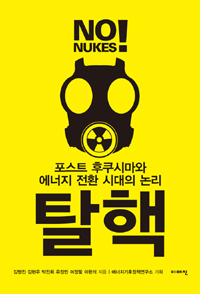Energy and Climate Policy Research Institute (South Korea) ed. 2011. Tal-Haek: Post-Fukushima wa Energy Jeonwhan Sidae-eui Nonri. 탈핵: 포스트 후쿠시마와 에너지 전환 시대의 논리 [Getting Off of Nuclear: Post-Fukushima and the Logic of Energy Transformation] Seoul: Imagine.
The nuclear disaster at Fukushima shocked South Korea, Japan’s geographically closest neighbor. Repercussions and responses within South Korea, however, have been multivalent. In contrast to Germany and other countries that have set out to stop or curtail nuclear power systems, the South Korean government has remained determined to increase its nuclear power capacity to provide for up to 59% of its entire electricity production by 2030. To implement its nuclear plans, the government recently designated a couple of sites for new nuclear power plant construction. Given other countries’ more cautious approach to nuclear power in the wake of Fukushima disaster, South Korea’s unabashed promotion of nuclear power suggests a need for wide attention and discussion.
A recently published collection of essays entitled Tal-Haek [脱核], the namesake of which refers to the “Getting Off of Nuclear” process, aims to do just this. The book project, organized by the Energy and Climate Policy Institute, a non-profit think tank that promotes a vision of “a world without nuclear power,” raises serious dissenting voices against the South Korean government’s nuclear power strategies. One essay by YU Jung Min, an expert in energy policy, particularly underscores the thematic concerns of the book through its attention to the similarities between Japan and South Korea in the “socio-political environments around nuclear power development.” Both countries relied on active government intervention to industrialize, Yu points out, and their nuclear power programs required their governments’ central planning and support. This government-led process created decision-making structures that did not embrace democratic and transparent procedures. Since both Japan and South Korea lacked natural resources for energy production, both welcomed nuclear power by invoking the concerns of energy security. Based on these observations, Yu and other authors call for “cautious social discussion on the energy policy in South Korea, one of the most active nuclear power nations in the world” (pp. 69-70).
In addition to Yu’s contribution, the lead essay by KIM Myung Jin surveys the history of nuclear power from the Manhattan Project, Three Mile Island and Chernobyl to the “Nuclear Renaissance” in the 21st century. LEE Heon Seok’s essay asks whether more nuclear power plants in Korea would be “a blessing or a disaster,” especially pointing out the lack of democratic procedures and legal bases in Korean government’s nuclear plant constructions. PARK Jin Hee, the Institute’s director, examines the history of Germany’s energy transition from the 1960s to the post-Fukushima period, suggesting a possible role model for South Korea’s reconsideration of its energy policy. The last essay by KIM Hyun Woo, which bears the namesake of the collection, argues that the anti-nuclear movement should consist of more than just slogans and offer a concrete “tal-haek scenario” based on quantitative analysis and action plans.
It remains to be seen whether this book would be successful in engendering more debates on nuclear power and related policy in Korean society, but the book will be useful for classroom discussions on Korea’s future direction in the post-Fukushima age.
–Chihyung Jeon
![[Teach311 + COVID-19] Collective](https://blogs.ntu.edu.sg/teach311/files/2020/04/Banner.jpg)